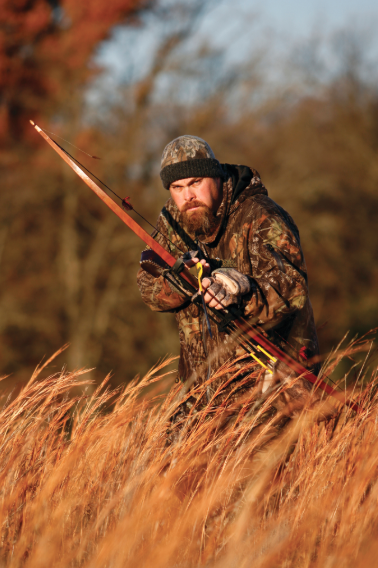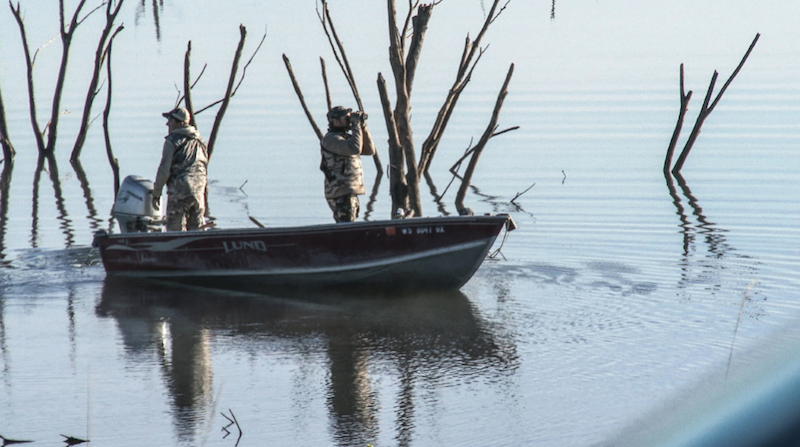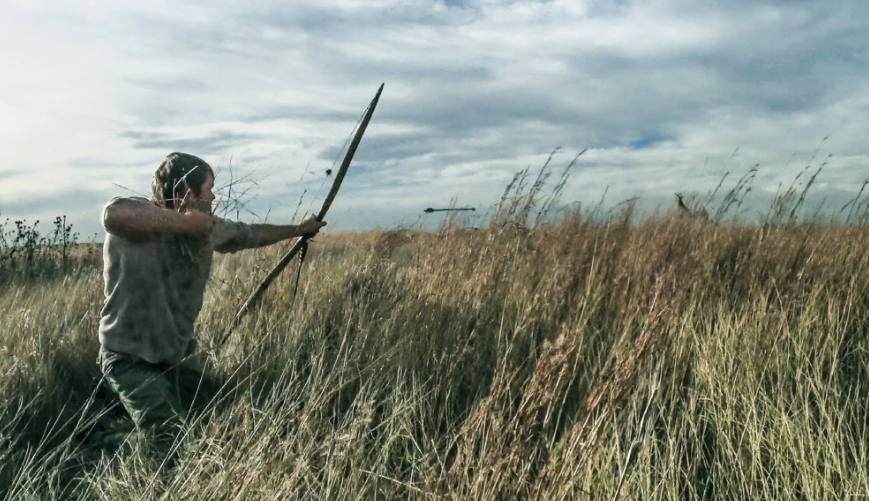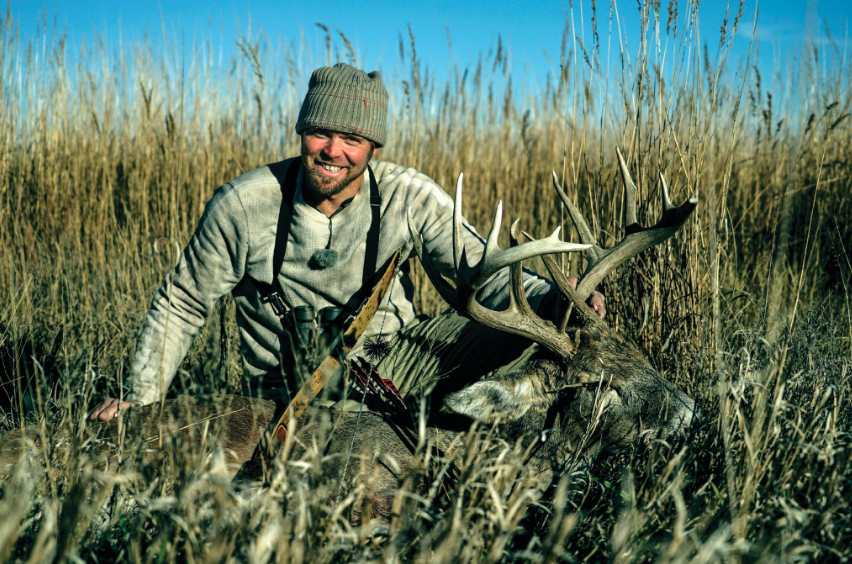Picture this: Nothing but a homemade deer decoy and wisps of prairie grass separate the enraged, stiff-legged buck from the bowhunter crouched behind the decoy, longbow in hand and adrenaline coursing through his veins. Within spitting distance, the wild public-land buck is oblivious to the archer’s plot. Instantly, the arrow rides the bow shelf, freezes in place, then launches and drives deep into the buck’s barrel-like chest. Death soon follows. No feeder, treestand, trail-camera data — none of it. Just an unadulterated, face-to-face meeting with stick and string — the way the natives did it.
At just 16 years old, Jared Scheffler identified that hunting from treestands for 45 minutes before school each morning wasn’t producing the results he desired. So, he slowly traded treestand hunting for a ground approach — a method he now uses exclusively to chase big whitetails, of which he’s killed many, including the buck referenced above.
Then and Now
Scheffler, now in his 30s, grew up on a modest west-central Wisconsin dairy farm. “Getting some venison meant food on the table,” he said. “My siblings and I weren’t given allowances, and we weren’t paid for farm chores. Hunting was an integral part of our existence. I constantly hunted and fished from my childhood up.”

“Probably the biggest factor in closing the deal is reading the animal,”said Jared Scheffler of Whitetail Adrenaline. “Developing that skill will help you know when to move, when to draw your bow and when to shoot." Photo: Whitetail Adrenaline
It’s possible that chasing whitetails on the ground runs in the Scheffler blood, for Jared’s father used the same technique. “I remember hunting with him as a child,” Scheffler recalled. “He worked long hours, so his bowhunting style was to always pop in and out of spots until he found productive areas. That aggressive style was basically engrained in me.”
Today, Jared Scheffler hunts whitetails more aggressively than ever before. The only difference is that his livelihood now hinges on it. You see, his entrepreneurial spirit led him to launch his own video-production business back in 2006. Yes, Scheffler makes ends meet by hunting, filming and selling his “Real as we could film it!” Whitetail Adrenaline DVDs to his loyal fan base.
Scheffler’s DVDs are unlike any other. First, they’re sponsor-free, meaning Scheffler relies solely on DVD and merchandise sales to make the wheels turn. Secondly, he and his crew hunt whitetails solely on public land and from ground level. Scheffler continually turns down offers to hunt with outfitters or on privately owned lands to remain true to his viewers. To boot, Scheffler’s bowhunting for the past several seasons has been exclusively with a longbow, which he’s used to take several bucks in the 130- to 150-inch range. Two have exceeded 170 inches! Those stats land Scheffler under the spotlight for this article.
Mobility = Encounters
Bowhunting mature deer on unfamiliar public land comes with steep odds. This is especially true on weeklong road-trip bowhunts when you’re confined to a treestand. “It typically takes longer to encounter bucks, and it’s easy to get hung up on hunting the same stand(s) over and over because it’s easy and within your comfort zone,” Scheffler warned.
“Hunting deer on the run, especially with a bow, is out of most people’s comfort zones,” he added. “However, leaving your comfort zone sparks new opportunities. For us, we sort through lots of acreage quickly to encounter more mature bucks in less time. If we screw up one stalk, we move on and find another buck. Our mobility gets us far more encounters than treestand hunting because we can locate more productive hunting spots.”
Of course, spots can go dead overnight. “There are many times when we hunt a property that’s hot one day, and cold the next,” he said. “Ground stalking helps us avoid spending excessive time in dead places. If things aren’t happening, we move on. We call it ‘looking for today’s hotspot.’ We generally move at a steady clip to determine if a property is worth our time. If things are dead, we continue moving until we find a reason to slow down or stop. But, we’re not confined to a 40-acre parcel. We’ve got thousands of public-land acres to work with.
“I no longer scout before hunting, and I don’t run trail cameras,” he continued. “Plus, I know from past experiences that it’s easy to get emotionally attached to a buck once you capture his picture. I no longer hold out for one specific buck. I must be flexible.”
Reduce Your Gear Load
To remain truly mobile, Scheffler recommends carrying only the essentials. “I hear it all the time: public-land hunters complaining about how much gear they must carry through the woods,” he said. “Plus, you sometimes haul all that gear only to find that someone else is already hunting where you intended to. The beauty of ground hunting is that you don’t need treestands and heavy bundles of climbing sticks. All you really need is your bow, although I always pack binoculars and sometimes a grunt tube and rattling antlers. This modest setup enables me to adapt and move quickly when situations call for it.”
Scheffler’s friend, Chancy Walters, killed two bucks scoring over 150-inches after Thanksgiving 2017 from the ground, all with basic gear. “I swear that guy has a grunt tube embedded in his throat,” Scheffler chuckled. “He can grunt really well with his mouth, even to bucks that are 400 yards away. He’s exceptional at reading deer and knowing when to grunt. This might surprise you: he killed both bucks last fall wearing a $10 pair of Walmart sneakers, a $22 pair of 4-way-stretch tan pants and a cheap thermal top that he streaked up with some paint. It proves you don’t need expensive gear, or a lot of it, to be successful.”
Getting Archery Close
It’s important to note that there isn’t a one-size-fits-all approach to getting close. “Calling works well if a buck is across the fence on private ground,” he shared. “However, if we’ve run out of cover while stalking a buck that’s on public land, we often just lay quietly and either wait until he comes to us or moves into a more suitable position for a stalk.
“When we hunt the timber in Minnesota and Wisconsin, we do lots of still hunting until we find places of interest,” he continued. “Then, we’ll put on the brakes, and sometimes sit and wait for a while to see if anything moves through.”
Scheffler uses another approach while hunting Iowa and Kansas. In Iowa, he and his team often use a boat to get a perspective most hunters cannot. Once they spot a mature buck, they bank the boat and move in on foot. Other times they’ll slink through stands of timber much like they do in Wisconsin. And, sometimes they hunt in the wide open behind a portable decoy. This mix of strategies annually yields shot opportunities.

The Whitetail Adrenaline crew uses multiple methods to find and approach giant bucks on public land. Here, they glass distant banks from a boat. Photo: Whitetail Adrenaline
“In Kansas, we often hunt the wide-open prairies with virtually no trees,” he said. “We spend most of our time driving from parcel to parcel and glassing from the road. We’ll often rack up 100–300 dirt-road miles a day. Mature bucks frequently push does out into the wide open and court them there until they’re ready to breed. They do this because they don’t like to be pestered, and few hunters attempt to approach bucks on flat land with only tall grass and the occasional ditch for cover.
“Many times, we simply belly crawl through the grass, and if we can’t get closer, we’ll just hold tight or pop up a decoy to challenge the buck,” he continued. “We’ve killed several bucks as they come stiff-legged right to the decoy.”
Scheffler advises treating each situation individually. “We’ve developed an instinct that guides every move we make,” he said. “However, I’m an analytical person, so when overthinking a situation overrides our instincts, we often miss out on getting close to a buck. Our initial instincts are usually right, so I must trust and run with our gut feelings rather than second-guess them.”
A Different Animal
Scheffler said that ground encounters are far different from treestand encounters. “Most shot opportunities are at alert deer, so you can usually anticipate that they’ll duck when you shoot, or they may turn and leave right as you prepare to release,” he said. “We carry rangefinders, but rarely do we have the opportunity to range, draw and shoot. Most often we estimate yardage, which can be difficult, especially when you have only a split second or two to guess the distance and shoot. We’ve missed our share of deer over the years. If we killed them all, the thrill would eventually wear off.
“Another challenge is that you’re often crawling on hands and knees, then faced with a quick shot opportunity,” he added. “Your muscles can become weak from all that crawling, and it can affect how you draw and shoot your bow. Most bowhunters would benefit from crawling around and shooting at 3-D targets during the offseason. I personally shoot a longbow, so yardage and where to hold are determined instinctively, but bowhunters using compounds should also consider practicing judging yardage during the offseason.”

When hunting from the ground, most shot opportunities are at alert deer. Learning when to draw and shoot is a game of reading the animal's behavior. Unfortunately, not every arrow connects. Photo: Whitetail Adrenaline
Get into the Rut
Bowhunters who schedule their rut vacations always risk missing peak daylight activity. It’s happened to me several times, and there I sit, bored out of my mind in a well-placed treestand wondering why I’m not seeing mature bucks.
“The rut can be unpredictable in many of the places we hunt, especially Kansas,” Scheffler said. “If you’re late and hit the lockdown phase, the tree belts that served as hot buck travel routes during the pre-rut often go dead. As I mentioned earlier, bucks usually lockdown in the wide open far from trees. By hunting aggressively on the ground, we can put ourselves back in the game and hunt those bucks. Even if you prefer to primarily hunt from treestands, ground hunting is a solid tool to keep you in the game, regardless if you hit the rut just right or not.”
Closing the Deal

This 160-inch public-land Kansas buck didn't come easy for Jared Scheffler. His resolve to never give up is often his best asset. Photo: Whitetail Adrenaline
Scheffler recalled that he bumped into one of his viewers while hunting in Kansas last fall. “He was watching a buck Chancy and I had spotted after driving hundreds of dirt-road miles for three days,” he told. “He said that it was his final day to hunt, and that he was going to attempt a stalk, so we left the area. The gentleman is a big dude, and most would think he couldn’t sneak up on a buck. But, he contacted me the next day and said that he’d gotten within 30 yards of the buck, but had blown the shot. It proves that anyone who watches the details, and puts their mind to it, can eventually get within bow range. Still, making the shot is tough, regardless of skill level.
“Probably the biggest factor in closing the deal is reading the animal,” Scheffler said. “Developing that skill will help you know when to move, when to draw your bow and when to shoot. There are times when an animal moves behind a rise, and we’ll run to close the gap as quickly as possible. In that case, being too careful would prevent us from closing the distance. On the other hand, if we move when a deer is looking our way, it’ll bust nearly every time before we even think about drawing our bows. You’ll learn what to do by putting yourself in situations. Experience is the best teacher there is, and instinctively reading deer comes from experience.”
Closing Thoughts
Ground hunting whitetails isn’t easy, but if you do it often, it can potentially produce more encounters with big bucks than treestand hunting. Don’t become discouraged if you try and fail. It’s a game of persistence and perseverance.
Scheffler believes ground hunting is a continual learning process. “I try to learn something each time we’re in the woods,” he said. “We still make mistakes, but we get lots of encounters, and we get multiple shot opportunities each year. I think any good hunter can do the same if they put their mind to it and work hard.”
Bonus: Must-Watch Resource
In Whitetail Adrenaline’s The Good, The Bad, The Ugly: Round 1, whitetail fanatic, Jared Scheffler, and his crew take you across the Midwest and Great Plains on action-packed, eye-level whitetail hunts. The DVD set keeps you at the edge of your seat with nail-biter action filmed at eye-level against wild, public-land whitetails. With 4¼ hours of footage, you’ll see the victories and failures of a unique, run-and-gun approach to bowhunting wily whitetails on their home turf. If watching arrow after arrow thumping buck after buck is your idea of entertainment, you won’t find it here. This is the raw documentation of man against beast, and the footage represents the challenges and difficulties that everyday bowhunters face while going head to head against North America’s most-pursued species on unforgiving public land.
Featured photo: Whitetail Adrenaline






